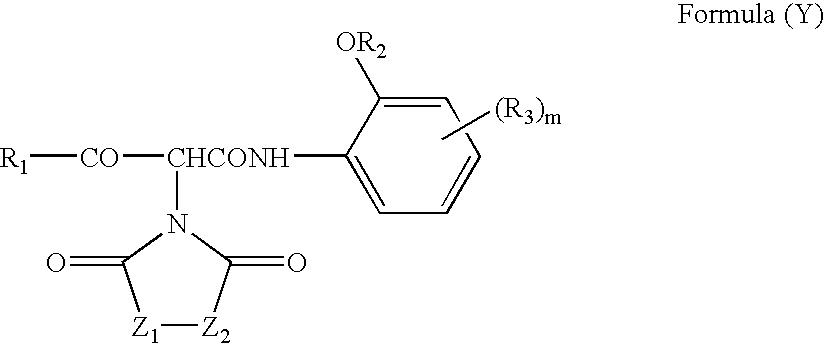Silver halide color photographic light-sensitive material
a color photographic and silver halide technology, applied in the direction of photosensitive materials, auxiliaries/base layers of photosensitive materials, instruments, etc., can solve the problems of reducing the maximum density (dmax), increasing fogging, and not being able to achieve the sensitivity necessary for digital exposur
- Summary
- Abstract
- Description
- Claims
- Application Information
AI Technical Summary
Benefits of technology
Problems solved by technology
Method used
Image
Examples
example 1-1
(Preparation of Emulsion B-1)
[0594]Using a method of simultaneously adding an aqueous silver nitrate solution and an aqueous sodium chloride solution mixed into stirring deionized distilled water containing a deionized gelatin, high silver chloride cubic grains were prepared. In the process of this preparation, the time period over which up to 3% of silver nitrate addition was finished was allocated to the nucleation section. At the step of from 3% to 80% addition of the entire silver nitrate amount, the addition speeds of the aqueous solution of silver nitrate and the aqueous solution of sodium chloride were picked up as a linear function of time. At the step of from 80% to 100% addition of the entire silver nitrate amount, potassium bromide (4.0 mol % per mol of the finished silver halide) was added. Potassium iodide (0.3 mol % per mol of the finished silver halide) was added with a vigorous stirring, at the step of completion of 90% addition of the entire silver nitrate amount. K...
example 1-2
(Preparation of Emulsion B-15)
[0658]In the preparation of Emulsion B-8, the addition speed in the nucleation section was changed. The addition amount of K2[RuCl5(NO)] was increased by twice. In the same manner as Emulsion B-8, excepting the changes mentioned above, Emulsion B-15 was prepared. The thus-obtained emulsion grains were monodisperse cubic silver iodobromochloride grains having a side length of 0.40 μm and a variation coefficient of 9.5% by observations and measurements using transmission electron micrographs (direct method). After being subjected to a sedimentation desalting treatment, the following were added to the resulting emulsion: deionized gelatin, Compounds Ab-1, Ab-2, and Ab-3, and calcium nitrate, and the emulsion was re-dispersed.
(Preparation of Emulsion B-16)
[0659]An emulsion B-16 was prepared in the same manner as Emulsion B-15, except that K2[IrCl5(H2O)] (2.0×10−7 mol, per mol of the finished silver halide) and K[IrCl4(H2O)2] (2.0×10−8 mol, per mol of the fi...
example 1-3
[0687]The evaluations were made according to the same method as in Example 1-2, except that the following Processing B was used in place of Processing A adopted in Example 1-2. The results obtained on the yellow images are shown in Table 6.
[0688]Standard photographic images were produced on a 127 mm-wide roll film sample, EVER-BEAUTY PAPER TYPE II for LASER (trade name, a product of Fuji Photo Film Co., Ltd.), by means of the following laser exposure. Thereafter, the exposed sample was continuously processed (running test) in the following processing steps, until an accumulated replenisher amount of the color developing solution reached to be equal to twice the color developer tank volume, using Digital Minilab Frontier 340 (trade name manufactured by Fuji Photo Film Co., Ltd.). A processing with this running processing solutions was named processing B. Additionally, in order to attain the following processing times in the processor, changes to the transport speed were made by modif...
PUM
| Property | Measurement | Unit |
|---|---|---|
| diameter | aaaaa | aaaaa |
| diameter | aaaaa | aaaaa |
| hydrophilic | aaaaa | aaaaa |
Abstract
Description
Claims
Application Information
 Login to View More
Login to View More - R&D
- Intellectual Property
- Life Sciences
- Materials
- Tech Scout
- Unparalleled Data Quality
- Higher Quality Content
- 60% Fewer Hallucinations
Browse by: Latest US Patents, China's latest patents, Technical Efficacy Thesaurus, Application Domain, Technology Topic, Popular Technical Reports.
© 2025 PatSnap. All rights reserved.Legal|Privacy policy|Modern Slavery Act Transparency Statement|Sitemap|About US| Contact US: help@patsnap.com



